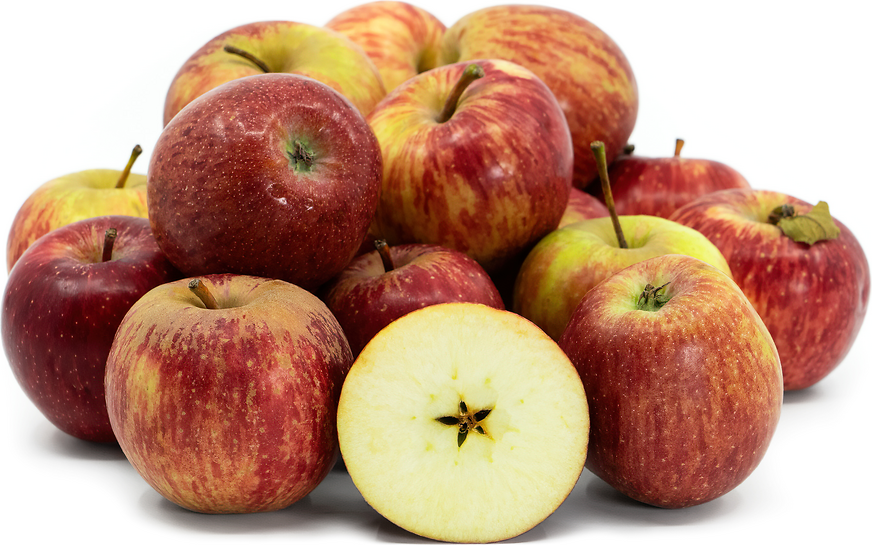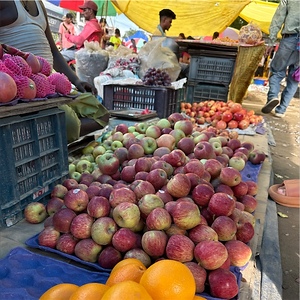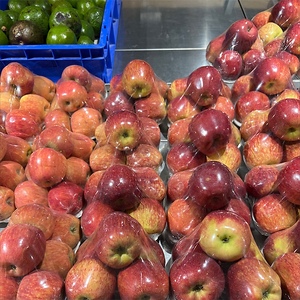


Shimla Apples
Estimated Inventory, lb : 0
Description/Taste
Shimla apples widely range in appearance as there are many different varieties generally labeled under the region-specific name. There are small, medium, to large varietals, and the apples have a round, oblate, to conical shape. Shimla apples can be smooth, taut, and glossy, waxy to matte, or textured and covered in russet. The skin varies from thin to semi-thick, depending on the variety, and has golden yellow to green base hues, covered in bright red, crimson, maroon, to cherry red blush, striping, and striations. Underneath the surface, the flesh typically showcases ivory, white, to cream-colored hues. Some varieties have a fine-grained, crisp, and aqueous consistency, while others have a grainy, crunchy, and chewy mouthfeel. Shimla apples may release strong to faint aromas when ripe, and the varieties will range in flavor from tangy and tart, mild, sweet, and delicate, to very sweet, fruity, and subtly floral.
Seasons/Availability
Shimla apples are available in the summer through winter in India.
Current Facts
Shimla apples, botanically classified as Malus domestica, is a general descriptor for apple varieties grown in a specific region in India, belonging to the Rosaceae family. Shimla is a city in northeastern India situated in the Himalayan foothills. The apple orchards are planted several thousand feet above sea level, creating a unique microclimate, and the fruits are cultivated on small plots of flat land or terraces. Many varieties of apples are grown in Shimla, including cultivars such as Red Delicious, Golden Delicious, Royal Delicious, Red Cap Valtod, Red Velox, Red Gold, Tydeman's Early, Granny Smith, Oregon Spur, Scarlet Spur, Gale Gala, Auvil Early Fuji, Super Chief, Red Chief, to local Indian varieties. Historically, when the apples were sent to domestic markets throughout India, they were generally labeled under the Shimla name and were sold through distributors. In the present day, there has been a recent movement among younger growers, self-labeled as "the third-generation," that have been using digital marketing and online platforms to take pre-orders directly from consumers, removing the middlemen to provide farm-to-table produce.
Nutritional Value
Shimla apples will vary in nutritional content, depending on the variety. In general, apples are a source of fiber to regulate the digestive tract, vitamin C to strengthen the immune system while reducing inflammation, and potassium to balance fluid levels within the body. Apples also provide copper to produce red blood cells, vitamin K to assist in faster wound healing, calcium to build strong bones and teeth, and other nutrients, including phosphorus, vitamin E, magnesium, manganese, iron, and zinc. Dark red apples have anthocyanins, which are pigmented compounds that have antioxidant-like properties to protect the cells against the damage caused by free radicals.
Applications
Shimla apples have a sweet flavor suited for fresh or cooked preparations. The apples are most consumed straight out of hand and will range in taste, texture, and juiciness depending on the specific variety. Shimla apples are versatile and can be incorporated into any recipe calling for fresh apples. The fruits can be chopped and added to slaws, tossed into green salads, stirred into dips, or mixed into fruit chaat, an Indian fruit salad. Shimla apples can also be used in chutney, stirred into yogurt, or sliced and served with dried fruits and cheeses. Some varieties of Shimla apples can be pressed into juice and used to flavor fruit punches, cocktails, and ciders, and other cultivars can be blended into smoothies. Beyond fresh preparations, Shimla apples can be added to sweet or savory cooked dishes and are popularly simmered into applesauce, jams, jellies, and preserves. Shimla apples can also be cooked into curries, stews, and vegetable dishes, roasted with meats or poached in liquids to create a tender consistency. Try sweet Shimla varieties in dessert recipes such as pies, crumbles, tarts, and strudels. In India, apples are cooked into a rich pudding called apple halwa. Some cultivars can also be pickled as a tangy condiment. Shimla apples pair well with fruits such as strawberries, bananas, oranges, peaches, and cherries, herbs including mint, basil, and parsley, and spices such as cinnamon, cardamom, ginger, and allspice. Whole, unwashed Shimla apples will keep for 1 to 3 months, depending on the specific variety, and should be stored in the refrigerator's crisper drawer.
Ethnic/Cultural Info
Himachal Pradesh is known as the “Apple State” and the “Apple Garden of India.” Apple cultivation accounts for over eighty percent of the fruit grown in the state, and within Himachal Pradesh, the city of Shimla produces the most apples for commercial sale, ninety percent of which are sold in domestic markets. Each year, Shimla hosts a two-day apple festival to celebrate the fruit's economic importance to the region. The apple festival attracts local and international visitors, and during the event, all the varieties grown in Shimla are presented on tables for taste testing and comparison. This event allows Shimla growers to present new varieties that have been created in the orchards and network with industry professionals for future business endeavors. The apple festival also features games and competitions, orchard tours, cooking contests using apples, and a contest to crown the annual Apple Queen.
Geography/History
Shimla apples are derived from several apple varieties that were introduced over time from the city of Shimla, the capital of Himachal Pradesh in northern India. Apples have been growing wild since ancient times in Central Asia. Throughout the Early Ages, various wild varieties were carried to India along trade routes, but these fruits were not often documented. One of the first records of domestic apples being introduced to India was through the British in 1838. Fruit trees were planted in Mussoorie and the Nilgiri Hills, and Captain R. C. Lee planted a professionally managed orchard in the Kullu Valley in 1870. Despite these introductions, locals mostly ignored apples, as many of the British apples grown, including red-flushed pippins, were cooking apples too sour to eat fresh. In 1904, Samuel Evans Stokes, missionary and son of a wealthy American businessman, moved to India and settled near Shimla, a city in the Himachal Pradesh state. While working as a missionary, Stokes saw the need for agricultural development in the region and eventually became a farmer to help boost the local economy. Stokes carried soil samples from India back to the United States in 1914 to test which apple variety was suited for the soil and settled on the Red Delicious variety, the most popular apple at the time in the United States. He planted a small orchard in India in 1916, and a few years later, his mother sent him a shipment of Golden Delicious apples to add to his orchard. Apples became widely accepted in India by 1928, and growers throughout Himachal Pradesh began growing Red Delicious and other varieties, creating an apple boom. Himachal Pradesh has a subtropical highland climate with cool winters and warm summers, producing a suitable environment to cultivate a wide selection of apples. Today apples grown in this region are generally labeled under the Shimla name and are sold in local markets across India as an affordable, everyday fruit.
Recipe Ideas
Recipes that include Shimla Apples. One
| The Forked Spoon |
|
Refreshing Kohlrabi, Beetroot, and Apple Salad with Feta and Lime |
| Skinny Miss |
|
Roasted Apple Cinnamon Sweet Potatoes |
| Williams Sonoma |
|
Roasted Apples with Spiced Bread Crumbs |









